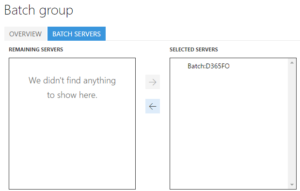Streamlining Batch Task Management in Microsoft Dynamics 365 Finance and Supply Chain Management
Posted on: February 12, 2024 | By: Fred Liu | Microsoft Dynamics AX/365, Microsoft Dynamics Manufacturing
In this blog we will explore batch task management in Microsoft Dynamics 365. Microsoft Dynamics 365 Finance and Supply Chain Management is a powerful tool for managing a wide range of business operations. A key aspect of ensuring these operations run smoothly is the efficient management of batch tasks. The introduction of features like “Priority Based Scheduling” and “Batch concurrency control” has significantly improved how businesses manage their workload. Let’s delve deeper into these advancements and their impact on operational efficiency.
Before Priority Based Scheduling: The Challenge of Managing Batch Tasks
Initially, managing batch tasks in Microsoft Dynamics 365 (D365) was a straightforward process: tasks were assigned to specific groups of batch servers. This method was effective for handling a large volume of tasks and controlling the number of tasks that could run concurrently. However, this approach had its limitations, especially when it came to preventing system overload.
Example Scenario: Imagine a situation where 60 tasks are scheduled to run at the same “normal” priority level. If all these tasks were to start at the same time, it would lead to full utilization of system resources for an extended period. This could cause delays, slow down other processes, and potentially lead to system crashes, highlighting the importance of effective batch task management.
The Introduction of Batch Concurrency Control
With the release of version 10.0.38, D365 saw the introduction of the “Batch concurrency control” feature. This feature allows administrators to set a limit on the number of tasks that can run concurrently within a batch group, offering a more nuanced approach to managing workload and preventing system overload.
Benefits of Batch Concurrency Control:
- Prevents System Overload: By setting a cap on the number of concurrent tasks, this feature helps prevent the system from being overwhelmed, ensuring that resources are utilized efficiently.
- Improves Operational Efficiency: It allows for smoother operation of critical processes by ensuring that essential tasks have the resources they need to run without interruption.
- Enhances User Experience: A more stable system means fewer disruptions for users, leading to increased satisfaction and productivity.
Activating the “Batch concurrency control” feature introduces a new setting for batch groups, providing clear guidelines for its use:
- Set the concurrency limit to zero if you do not need to control task concurrency.
- To halt all tasks in a group, set the limit to -1.
- For groups with over 5000 tasks ready to run, avoid setting a limit to prevent potential scheduling issues.
This feature is crucial for businesses looking to optimize their batch task management strategy. It builds on the previous strategy of selecting only a few servers for a batch group, thereby improving the ability to manage tasks more effectively.
Challenges:
- System Overload: Without proper management, the risk of overwhelming the system with too many concurrent tasks is high.
- Operational Delays: Inefficiencies in task management can lead to delays in critical operations, affecting overall business performance.
- Reduced Productivity: When the system is strained, users may experience slowdowns or interruptions, reducing productivity and negatively impacting the user experience.
Advantages of Effective Batch Task Management:
- Optimized Resource Utilization: By controlling the number of concurrent tasks, resources are allocated more efficiently, preventing bottlenecks.
- Enhanced System Stability: A well-managed system is more stable and reliable, ensuring that business operations can run smoothly without unexpected disruptions.
- Improved Business Outcomes: With smoother operations, businesses can expect better performance, increased productivity, and higher user satisfaction.
Next Steps:
If you want to learn more about Streamlining Batch Task Management in Microsoft Dynamics 365 Finance and Supply Chain Management, contact us here to learn how we can help you grow your business. You can also email us at info@loganconsulting.com or call (312) 345-8817.
Related Posts
-
Automatic Prepayments to Vendors with Microsoft Dynamics 365 Finance
Posted on: April 24, 2024
In the modern business landscape, managing financial transactions efficiently and accurately is extremely important. Microsoft Dynamics 365 Finance offers an...
-
Enhancing Expense Management with Microsoft Dynamics 365 Finance: An Overview Guide
Posted on: April 22, 2024
Managing expenses efficiently in a dynamic business environment is important for maintaining budget control and ensuring financial compliance. Microsoft Dynamics...

